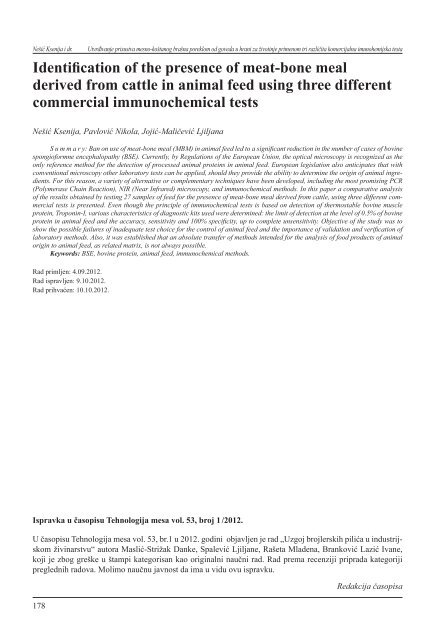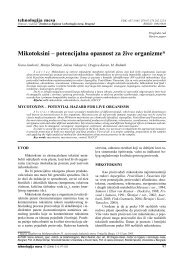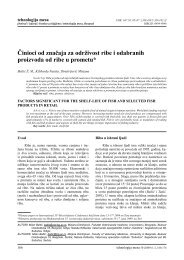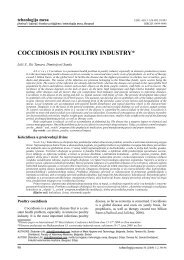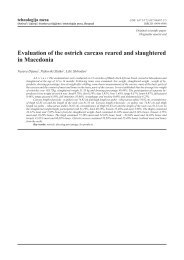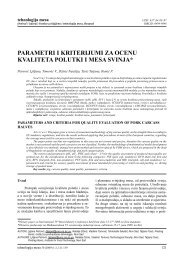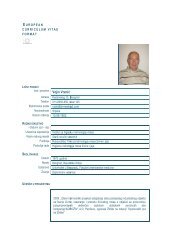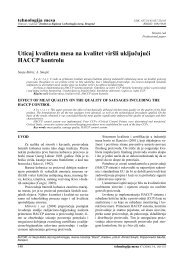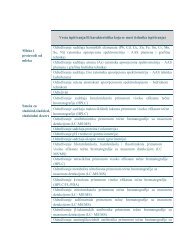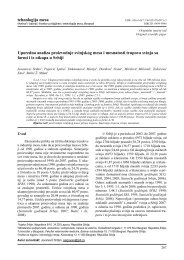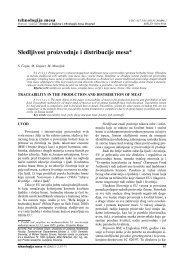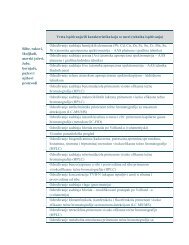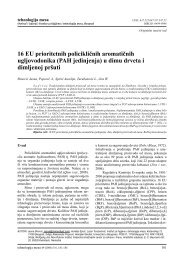Najnoviji broj Äasopisa - inmesbgd.com
Najnoviji broj Äasopisa - inmesbgd.com
Najnoviji broj Äasopisa - inmesbgd.com
You also want an ePaper? Increase the reach of your titles
YUMPU automatically turns print PDFs into web optimized ePapers that Google loves.
Nešić Ksenija i dr.<br />
Utvrđivanje prisustva mesno-koštanog brašna poreklom od goveda u hrani za životinje primenom tri različita komercijalna imunohemijska testa<br />
Identification of the presence of meat-bone meal<br />
derived from cattle in animal feed using three different<br />
<strong>com</strong>mercial immunochemical tests<br />
Nešić Ksenija, Pavlović Nikola, Jojić-Maličević Ljiljana<br />
S u m m a r y: Ban on use of meat-bone meal (MBM) in animal feed led to a signifi cant reduction in the number of cases of bovine<br />
spongioformne encephalopathy (BSE). Currently, by Regulations of the European Union, the optical microscopy is recognized as the<br />
only reference method for the detection of processed animal proteins in animal feed. European legislation also anticipates that with<br />
conventional microscopy other laboratory tests can be applied, should they provide the ability to determine the origin of animal ingredients.<br />
For this reason, a variety of alternative or <strong>com</strong>plementary techniques have been developed, including the most promising PCR<br />
(Polymerase Chain Reaction), NIR (Near Infrared) microscopy, and immunochemical methods. In this paper a <strong>com</strong>parative analysis<br />
of the results obtained by testing 27 samples of feed for the presence of meat-bone meal derived from cattle, using three different <strong>com</strong>mercial<br />
tests is presented. Even though the principle of immunochemical tests is based on detection of thermostable bovine muscle<br />
protein, Troponin-I, various characteristics of diagnostic kits used were determined: the limit of detection at the level of 0.5% of bovine<br />
protein in animal feed and the accuracy, sensitivity and 100% specifi city, up to <strong>com</strong>plete unsensitivity. Objective of the study was to<br />
show the possible failures of inadequate test choice for the control of animal feed and the importance of validation and verifi cation of<br />
laboratory methods. Also, it was established that an absolute transfer of methods intended for the analysis of food products of animal<br />
origin to animal feed, as related matrix, is not always possible.<br />
Keywords: BSE, bovine protein, animal feed, immunochemical methods.<br />
Rad primljen: 4.09.2012.<br />
Rad ispravljen: 9.10.2012.<br />
Rad prihvaćen: 10.10.2012.<br />
Ispravka u časopisu Tehnologija mesa vol. 53, <strong>broj</strong> 1 /2012.<br />
U časopisu Tehnologija mesa vol. 53, br.1 u 2012. godini objavljen je rad „Uzgoj <strong>broj</strong>lerskih pilića u industrijskom<br />
živinarstvu“ autora Maslić-Strižak Danke, Spalević Ljiljane, Rašeta Mladena, Branković Lazić Ivane,<br />
koji je zbog greške u štampi kategorisan kao originalni naučni rad. Rad prema recenziji priprada kategoriji<br />
preglednih radova. Molimo naučnu javnost da ima u vidu ovu ispravku.<br />
178<br />
Redakcija časopisa


